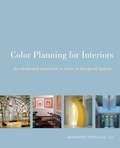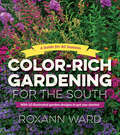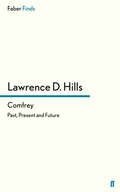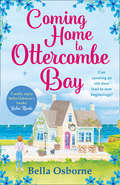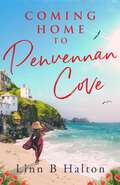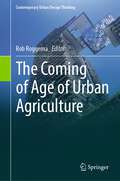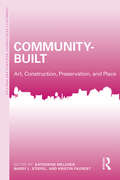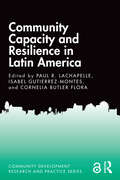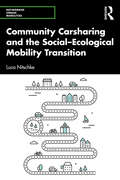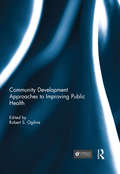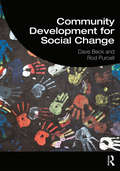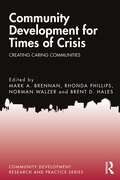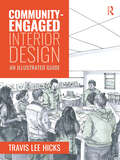- Table View
- List View
Color Planning for Interiors: An Integrated Approach to Color in Designed Spaces
by Margaret PortilloEvidence-based approach to color planning lets you discover the impact of color on people and space. You'll learn to systematically develop innovative, holistic color solutions in interior design with this book's evidence-based approach to color planning. The author sets forth a color planning framework that integrates multiple criteria, enabling you to fully consider the complex role that color plays in interior design. Color Planning for Interiors is based on the findings from a national study that the author conducted, which identified five categories of color criteria: Color as Composition Color Preferences Color as Communication Color Pragmatics Color for Engagement The author interviewed noted designers and colorists about the projects that best represented their approach to color. As a result, you'll discover how leaders in the field examine color from compositional, symbolic, behavioral, preferential, and pragmatic perspectives in order to arrive at a carefully considered solution. Moreover, you'll see how designers and architects apply this knowledge to a broad range of interior spaces, including workplaces, restaurants, retail settings, healthcare facilities, and private residences. Complementing theory and research, real-life examples are presented from interior design projects that consider color in relation to light, materiality, and interior architecture. In addition, full-color diagrams, photographs, and design renderings illustrate concepts throughout the book to help you understand how to select and work with color. From the fundamental principles of color theory to innovative applications, all aspects of designing interiors with color are examined, making this book ideal for all professionals and students in interior design who want to develop the full potential of their color palettes.
Color Plus Design: Transforming Interior Space - with STUDIO
by Ronald ReedLearn how to create unified and visually inviting spaces with the third edition of Color Plus Design. Author Ron Reed shows how color and design theory, when used together, can produce successful spaces that help designers avoid common color mistakes in a variety of residential and commercial interiors. Students will gain an appreciation of how different cultures around the world use color in their designs, and learn how to effectively use color in conjunction with key design principles such as balance, rhythm, emphasis, proportion, scale, unity, harmony, and variety.Features-Brand new chapter on Color and Health explores how color affects human perception, emotions, wellness, and misconceptions -Updated art program illustrates how a space takes on different spatial characteristics through color manipulation -Key pedagogical features include learning objectives, review questions, key terms, and end of chapter exercises for overall comprehension Instructor Resources -Instructor's Guide provides suggestions for planning the course and using the text in the classroom, supplemental assignments, and lecture notes -Test Bank includes sample test questions for each chapter -PowerPoint® presentations include images from book and provide a framework for lecture and discussion STUDIO Resources -Study smarter with self-quizzes featuring scored results and personalized study tips -Review concepts with flashcards of essential vocabulary -Download interactive exercises and their solutions, to test your knowledge of color
Color-Rich Gardening for the South: A Guide for All Seasons
by Roxann WardIn this gardening guide for the South, Roxann Ward shows how color provides one of the easiest and most impressive ways to shape a garden with intense eye appeal. The book is built around ten original design templates—"Ode to the Camellia," "A Spring Kitchen Garden to Delight the Senses," "A Carefree Border with Summer-Blooming Bulbs," to name a few. Each template provides detailed instructions for a trouble-free start while offering plenty of room to adapt designs in ways you might not have before imagined. With Ward's signature approach to plantings of annual flowers layered with bulbs, perennials, woody ornamentals, and fruiting shrubs, you will soon be combining beloved southern plants with new plant varieties to create lively, long-lasting color displays. *Provides 10 beautiful and flexible templates to get you started*Features gardens with uniquely southern looks that will thrive in USDA zones 6b-8b, including 15 southern states *Useful for both beginning and experienced gardeners, as well as for commercial landscapers*Highlights organic practices and solutions*Gives step-by-step instructions for choosing locations, preparing soil and garden beds, selecting the best plants, designing, landscaping, sustaining your garden through the seasons, and much more*Richly illustrated with photographs, plant lists, and other resources
Colour Recipes for Painted Furniture: 42 step-by-step projects to transform your home
by Annie SloanWith this book in one hand and a brush in the other, you can learn how to transform everyday furniture into something special, all for the price of a pot of paint. Annie Sloan is a paint legend and one of the world’s most popular experts in the field of decorative painting. In Colour Recipes for Painted Furniture and more, Annie presents 40 new projects and ideas, showing you the easy way to update tired furniture and transform your home. Working with her own range of chalk paints, Annie shows how to mix colours and how to achieve certain looks. Whether your taste is for colourful boho chic or restrained Swedish hues, cosy and comforting rustic shades, a modern and contemporary approach or an elegant French look, here you will find a project to suit you. Start off by mastering the simple art of colourwashing, and work your way up to transfer printing, gilding, stencilling and glazing. There are even instructions for dyeing fabric using paint. As well as painting furniture, the projects range from a staircase painted in a rainbow of colours to stencilled walls, transforming floors with a coat of paint to dyeing linen curtains and even painting a vintage chandelier. Throughout the book, Annie offers expert tips, techniques, shortcuts and guidance, showing you the easy way to create a stylish home.
Colourful
by Iris ApfelIris Apfel’s legacy29 August 1921 to 1 March 2024.In the summer of 2023, as Iris Apfel welcomed her 102nd birthday, she put pen to paper to write this very special project: what Iris called her legacy book.Comprising of over 200 personal photos and adorned with beautiful, unseen fabric patterns from her Old World Weaver’s collection, Iris’s incredible energy radiates from every page. Here she shares her creative work, life stories, adventures, and her unwavering belief in the essential power of colour and creativity on a life well lived.'It has been an honour to know and to learn from Iris.' Ruvén Afanador'A force of nature.' Tommy Hilfiger'One of the industry’s oldest tastemakers.' VogueThis is not a book of secrets – I have no secrets. Sorry to disappoint if that’s what you’re looking for. I have some good stories though. And a few ideas. This book is about living, creating and colour. Because creativity and colour matter. I don’t want you to dress like me or think like me – that’s not the idea of this book. I want you to find the colours, confidence and creative inspiration that reflect you. My life has been filled with love, wonder and a very deep, incurable curiosity. This book is my treasure trove of inspiration, influences and ideas: My source. Be brave. Find your source. What makes you happy?Much love, Iris x
Comfrey: Past, Present and Future (Conservation Gardening And Farming Ser. #Ser. C)
by Lawrence D. HillsComfrey is noted by both organic gardeners and herbalists for its great usefulness and versatility. Of particular interest is the 'Bocking 14' cultivar of Russian Comfrey. This strain was developed during the 1950s by Lawrence D. Hills, who founded the organic gardening organization now known as Garden Organic.Lawrence D. Hills was the world authority on comfrey. In this book, he wrote for farmers and gardeners in all countries, showing how this useful plant could be cultivated in both tropical and temperate zones to produce a crop equally rewarding for gardener, smallholder and mechanized farmer. Subtitled 'Past, Present and Future,' on its publication in 1976, this was the most comprehensive survey of the properties and cultivation of comfrey ever, and Comfrey remains undoubtedly the essential book on the subject, as well as a lasting testament to Lawrence D. Hills's indefatigable efforts to achieve a better understanding of it.
Coming Home to Ottercombe Bay
by Bella OsborneOttercombe Bay was originally published as a four-part serial. This is the complete story in one package.
Coming Home to Penvennan Cove (The Penvennan Cove series)
by Linn B. HaltonCan Kerra's Cornish hometown offer the fresh start she needs? When Kerra left the quiet Cornish town of Penvennan Cove for the bright lights of London she didn't look back. But after the death of her mother, she's decided it's time to face her past and return to the place she called home. Her father needs her, and perhaps she needs him more than she's willing to admit? Tackling town gossip, home renovations and a flame from her past, it's not quite smooth sailing for Kerra. Ross is the bad boy she was meant to forget, not a man who still sets her heart aflutter. As he helps bring her dream home to life, they begin to break down the barriers that have been holding them back and in the process learn things about themselves they never thought possible. As friends old and new come together, the future in Penvennan looks bright. Perfect for fans of Milly Johnson, Phillipa Ashley and Julie Houston.
The Coming of Age of Urban Agriculture (Contemporary Urban Design Thinking)
by Rob RoggemaFor a long time, urban agriculture initiatives have been explored and novel policy and planning practices have been investigated. With the global food crisis the role urban agriculture has to play becomes more and more urgent. The potentials are large: it brings social justice, it limits climate change, it provides a healthy urban condition, it stimulates biodiversity and gives disadvantaged people an economic opportunity. After 15 years in the making, the time is ripe to see whether the growing of food has established a prominent position in urban planning and policies, food productivity, safety and security, social well-being, the arts, and human health. In this volume several aspects of growing food in the city are explored. Urban Agriculture plays a significant role in society. Nevertheless, it did not become a mainstream topic in day-to-day practice. This book provides concrete solutions and clues how to give urban food production a crucial role in the future planning of urban environments.
Common hair cap moss (large print)
by RnibThis is an image of a Common Hair-cap Moss (Polytrichum commune) sporophyte. This has grown from a zygote, the result of the fusing of male and female gametes on the green plant (gametophyte). The sporophyte remains attached to the green plant.There is a locator dot shown, which will be at the top left of the page when the image is the correct way up.The moss is fixed in the ground at the bottom centre of the page. Going up from here there are narrow leaves growing out to the left and right from the stem. There are brown leaves at the bottom and green leaves further up.The stem continues up the page.You will find the plans capsule containing spores at the top of the image. It has a lid, with beak on top, which opens to release the spores; these will grow into new green plants.Like most mosses the Hair-cap grows in moist habitats: wet heathland or bogs. Its height ranges from 5 to 30 centimetres. Many plants will grow together to form a thick mat.
Common hair cap moss (UEB contracted)
by RnibThis is an image of a Common Hair-cap Moss (Polytrichum commune) sporophyte. This has grown from a zygote, the result of the fusing of male and female gametes on the green plant (gametophyte). The sporophyte remains attached to the green plant.There is a locator dot shown, which will be at the top left of the page when the image is the correct way up.The moss is fixed in the ground at the bottom centre of the page. Going up from here there are narrow leaves growing out to the left and right from the stem. There are brown leaves at the bottom and green leaves further up.The stem continues up the page.You will find the plans capsule containing spores at the top of the image. It has a lid, with beak on top, which opens to release the spores; these will grow into new green plants.Like most mosses the Hair-cap grows in moist habitats: wet heathland or bogs. Its height ranges from 5 to 30 centimetres. Many plants will grow together to form a thick mat.
Common hair cap moss (UEB uncontracted)
by RnibThis is an image of a Common Hair-cap Moss (Polytrichum commune) sporophyte. This has grown from a zygote, the result of the fusing of male and female gametes on the green plant (gametophyte). The sporophyte remains attached to the green plant.There is a locator dot shown, which will be at the top left of the page when the image is the correct way up.The moss is fixed in the ground at the bottom centre of the page. Going up from here there are narrow leaves growing out to the left and right from the stem. There are brown leaves at the bottom and green leaves further up.The stem continues up the page.You will find the plans capsule containing spores at the top of the image. It has a lid, with beak on top, which opens to release the spores; these will grow into new green plants.Like most mosses the Hair-cap grows in moist habitats: wet heathland or bogs. Its height ranges from 5 to 30 centimetres. Many plants will grow together to form a thick mat.
Community-Built: Art, Construction, Preservation, and Place (Community Development Research and Practice Series)
by Katherine Melcher Barry Stiefel Kristin FaurestThroughout history and around the world, community members have come together to build places, be it settlers constructing log cabins in nineteenth-century Canada, an artist group creating a waterfront gathering place along the Danube in Budapest, or residents helping revive small-town main streets in the United States. What all these projects have in common is that they involve local volunteers in the construction of public and community places; they are community-built. Although much attention has been given to specific community-built movements such as public murals and community gardens, little has been given to defining community-built as a whole. This volume provides a preliminary description of community-built practices with examples from the disciplines of urban design, historic preservation, and community art. Taken as a whole, these community-built projects illustrate how the process of local involvement in adapting, building, and preserving a built environment can strengthen communities and create places that are intimately tied to local needs, culture, and community. The lessons learned from this volume can provide community planners, grassroots facilitators, and participants with an understanding of what can lead to successful community-built art, construction, preservation, and placemaking.
Community-Built: Art, Construction, Preservation, and Place (Community Development Research and Practice Series)
by Katherine Melcher Barry Stiefel Kristin FaurestThroughout history and around the world, community members have come together to build places, be it settlers constructing log cabins in nineteenth-century Canada, an artist group creating a waterfront gathering place along the Danube in Budapest, or residents helping revive small-town main streets in the United States. What all these projects have in common is that they involve local volunteers in the construction of public and community places; they are community-built. Although much attention has been given to specific community-built movements such as public murals and community gardens, little has been given to defining community-built as a whole. This volume provides a preliminary description of community-built practices with examples from the disciplines of urban design, historic preservation, and community art. Taken as a whole, these community-built projects illustrate how the process of local involvement in adapting, building, and preserving a built environment can strengthen communities and create places that are intimately tied to local needs, culture, and community. The lessons learned from this volume can provide community planners, grassroots facilitators, and participants with an understanding of what can lead to successful community-built art, construction, preservation, and placemaking.
Community Capacity and Resilience in Latin America (Community Development Research and Practice Series)
by Paul R. Lachapelle Isabel Gutierrez-Montes Cornelia Butler FloraCommunity Capacity and Resilience in Latin America addresses the role of communities in building their capacity to increase resiliency and carry out rural development strategies in Latin America. Resiliency in a community sense is associated with an ability to address stress and respond to shock while obtaining participatory engagement in community assessment, planning and outcome. Although the political contexts for community development have changed dramatically in a number of Latin American countries in recent years, there are growing opportunities and examples of communities working together to address common problems and improve collective quality of life. This book links scholarship that highlights community development praxis using new frameworks to understand the potential for community capacity and resiliency. By rejecting old linear models of development, based on technology transfer and diffusion of technology, many communities in Latin America have built capacity of their capital assets to become more resilient and adapt positively to change. This book is an essential resource for academics and practitioners of rural development, demonstrating that there is much we can learn from the skills of self-diagnosis and building on existing assets to enhance community capitals. Chapter 3 of this book is freely available as a downloadable Open Access PDF at http://www.taylorfrancis.com under a Creative Commons Attribution (CC-BY) 4.0 license.
Community Capacity and Resilience in Latin America (Community Development Research and Practice Series)
by Paul R. Lachapelle Isabel Gutierrez-Montes Cornelia Butler FloraCommunity Capacity and Resilience in Latin America addresses the role of communities in building their capacity to increase resiliency and carry out rural development strategies in Latin America. Resiliency in a community sense is associated with an ability to address stress and respond to shock while obtaining participatory engagement in community assessment, planning and outcome. Although the political contexts for community development have changed dramatically in a number of Latin American countries in recent years, there are growing opportunities and examples of communities working together to address common problems and improve collective quality of life. This book links scholarship that highlights community development praxis using new frameworks to understand the potential for community capacity and resiliency. By rejecting old linear models of development, based on technology transfer and diffusion of technology, many communities in Latin America have built capacity of their capital assets to become more resilient and adapt positively to change. This book is an essential resource for academics and practitioners of rural development, demonstrating that there is much we can learn from the skills of self-diagnosis and building on existing assets to enhance community capitals. Chapter 3 of this book is freely available as a downloadable Open Access PDF at http://www.taylorfrancis.com under a Creative Commons Attribution (CC-BY) 4.0 license.
Community Carsharing and the Social–Ecological Mobility Transition (Networked Urban Mobilities Series)
by Luca NitschkeThis book investigates how practices of community carsharing are influencing everyday mobility. It argues that hegemonic practices of automobility are reconfigured through practices of community carsharing, thereby challenging capitalist mobilities in the realm of everyday life. Through a detailed empirical study of practices of community carsharing and its practitioners in the rural regions around Munich, Germany, this book reveals how the practice contributes to the emergence of alternative automobile practices, meanings, identities and subjectivities. It also explores the embedding of automobility into its ecological context, the connection of function and community in practices of community carsharing and the changing of ownership relations through a process of commoning mobility. This reconfiguration of everyday practices of automobility takes place through processes of everyday resistance, re-embedding and commoning, and ultimately results in the emergence of an alternative mobility culture, thereby facilitating the dissemination of an alternative common sense of community carsharing. This book on community carsharing provides a valuable insight into carsharing in rural settings and exemplifies how carsharing specifically, and sharing mobilities in general, can contribute to a social–ecological mobility transition. The work will be of particular interest to scholars and practitioners working in mobility studies and mobilities.
Community Carsharing and the Social–Ecological Mobility Transition (Networked Urban Mobilities Series)
by Luca NitschkeThis book investigates how practices of community carsharing are influencing everyday mobility. It argues that hegemonic practices of automobility are reconfigured through practices of community carsharing, thereby challenging capitalist mobilities in the realm of everyday life. Through a detailed empirical study of practices of community carsharing and its practitioners in the rural regions around Munich, Germany, this book reveals how the practice contributes to the emergence of alternative automobile practices, meanings, identities and subjectivities. It also explores the embedding of automobility into its ecological context, the connection of function and community in practices of community carsharing and the changing of ownership relations through a process of commoning mobility. This reconfiguration of everyday practices of automobility takes place through processes of everyday resistance, re-embedding and commoning, and ultimately results in the emergence of an alternative mobility culture, thereby facilitating the dissemination of an alternative common sense of community carsharing. This book on community carsharing provides a valuable insight into carsharing in rural settings and exemplifies how carsharing specifically, and sharing mobilities in general, can contribute to a social–ecological mobility transition. The work will be of particular interest to scholars and practitioners working in mobility studies and mobilities.
Community Development Approaches to Improving Public Health (Community Development – Current Issues Series)
by Robert S. OgilvieAs the rates of chronic diseases, like diabetes, asthma and obesity skyrocket, research is showing that the built environment – the way our cities and towns are developed – contributes to the epidemic rates of these diseases. It is unlikely that those who planned and developed these places envisioned these situations. Public health, community development planning, and other fields influencing the built environment have operated in isolation for much of recent history, with the result being places that public health advocates have labelled, ‘designed for disease’. The sad irony of this is that planning and public health arose together, in response to the need to create health standards, zoning and building codes to combat the infectious diseases that were prevalent in the industrializing cities of late nineteenth and early twentieth century America. In recent years, the dramatic rise in chronic disease rates in cities and towns has begun to bring public health and planning back together to promote development pattern and policies facilitating physical activity and neighbourly interactions as antidotes. In this book, a number of such community development efforts are highlighted, bringing attention to the need to coordinate planning, community development and health policy. This book was originally published as a special issue of Community Development.
Community Development Approaches to Improving Public Health (Community Development – Current Issues Series)
by Robert S. OgilvieAs the rates of chronic diseases, like diabetes, asthma and obesity skyrocket, research is showing that the built environment – the way our cities and towns are developed – contributes to the epidemic rates of these diseases. It is unlikely that those who planned and developed these places envisioned these situations. Public health, community development planning, and other fields influencing the built environment have operated in isolation for much of recent history, with the result being places that public health advocates have labelled, ‘designed for disease’. The sad irony of this is that planning and public health arose together, in response to the need to create health standards, zoning and building codes to combat the infectious diseases that were prevalent in the industrializing cities of late nineteenth and early twentieth century America. In recent years, the dramatic rise in chronic disease rates in cities and towns has begun to bring public health and planning back together to promote development pattern and policies facilitating physical activity and neighbourly interactions as antidotes. In this book, a number of such community development efforts are highlighted, bringing attention to the need to coordinate planning, community development and health policy. This book was originally published as a special issue of Community Development.
Community Development for Social Change
by Dave Beck Rod PurcellCommunity Development for Social Change provides a comprehensive introduction to the theory and practice of community development and associated activities, discusses best practice from global experience and links that to the UK context. The book integrates the realities of practice to key underpinning theories, human rights, values and a commitment to promoting social justice. A range of practice models are described and analysed, including UK models, popular education and community organising, as well as a range of practice issues that need to be understood by community development workers. For example, strategies to promote individual and community empowerment, challenging discrimination, building and sustaining groups, and critical reflection on practice. Finally, a range of case studies from the UK and overseas illustrates good practice in diverse contexts. These case studies are analysed with reference to the values of community development, the promotion of social justice and the underpinning theories. It is an essential text for those on community development courses as well as for a range of workers, including local government, national and local voluntary agencies, and community-based organisations.
Community Development for Social Change
by Dave Beck Rod PurcellCommunity Development for Social Change provides a comprehensive introduction to the theory and practice of community development and associated activities, discusses best practice from global experience and links that to the UK context. The book integrates the realities of practice to key underpinning theories, human rights, values and a commitment to promoting social justice. A range of practice models are described and analysed, including UK models, popular education and community organising, as well as a range of practice issues that need to be understood by community development workers. For example, strategies to promote individual and community empowerment, challenging discrimination, building and sustaining groups, and critical reflection on practice. Finally, a range of case studies from the UK and overseas illustrates good practice in diverse contexts. These case studies are analysed with reference to the values of community development, the promotion of social justice and the underpinning theories. It is an essential text for those on community development courses as well as for a range of workers, including local government, national and local voluntary agencies, and community-based organisations.
Community Development for Times of Crisis: Creating Caring Communities (Community Development Research and Practice Series)
by Mark A. BrennanThis book explores the intersection of community development and local capacity building as a basis for effective disaster mitigation and the alleviation of suffering in times of crisis. Beginning with the Community Development section, the process, context, and methods for community, engagement, and development can be viewed from different structural and logical approaches. This section explores some of the more relevant historical arguments, as well as more contemporary examinations. The second section looks at Critical Human and Community Considerations and sheds light on some of the key concepts that are often overlooked (poverty, race, inequality, social justice, mental health, social division) when framing community responses to disaster. The third section focuses on Fundamental Elements of Caring Communities. This section explores the importance, practical, and measurable impacts of social support, empathy, inclusion, and conflict resolution in creating effective and caring community responses. Finally, the last section focuses on practice and brings together research and theory into applied programming, examples, and evidence from on-the-ground efforts to establish caring communities that respond to local needs in times of crisis and beyond. By addressing these objectives, this book provides a more complete understanding of the essential role that community can play in disaster mitigation. Doing this will provide a better focus for ongoing research endeavors, and program and policy initiatives at the community level that seek to prepare for, respond to, and recover from natural and other disasters. As a result, this book contributes to wider and more sustainable development of our communities beyond disasters, while furthering dialog among community scholars and practitioners.
Community Development for Times of Crisis: Creating Caring Communities (Community Development Research and Practice Series)
by Mark A. Brennan Rhonda Phillips Norman Walzer Brent D. HalesThis book explores the intersection of community development and local capacity building as a basis for effective disaster mitigation and the alleviation of suffering in times of crisis. Beginning with the Community Development section, the process, context, and methods for community, engagement, and development can be viewed from different structural and logical approaches. This section explores some of the more relevant historical arguments, as well as more contemporary examinations. The second section looks at Critical Human and Community Considerations and sheds light on some of the key concepts that are often overlooked (poverty, race, inequality, social justice, mental health, social division) when framing community responses to disaster. The third section focuses on Fundamental Elements of Caring Communities. This section explores the importance, practical, and measurable impacts of social support, empathy, inclusion, and conflict resolution in creating effective and caring community responses. Finally, the last section focuses on practice and brings together research and theory into applied programming, examples, and evidence from on-the-ground efforts to establish caring communities that respond to local needs in times of crisis and beyond. By addressing these objectives, this book provides a more complete understanding of the essential role that community can play in disaster mitigation. Doing this will provide a better focus for ongoing research endeavors, and program and policy initiatives at the community level that seek to prepare for, respond to, and recover from natural and other disasters. As a result, this book contributes to wider and more sustainable development of our communities beyond disasters, while furthering dialog among community scholars and practitioners.
Community-Engaged Interior Design: An Illustrated Guide
by Travis Lee HicksThis step-by-step guide takes the reader through each stage of the design process, from concept to completion, exploring practical methods of how to engage the community throughout interior architecture and design projects. This book argues that all design should be accomplished through a process of engagement, be it with community members, clients, or end users. The community-engaged designer welcomes participatory processes, mutually beneficial collaboration, and equitable inclusion in order to meet the needs and wants of diverse groups of people. Chapters cover the initial engagement of communities, marketing, and pre-design phases, translating research into a design scheme in development with the community, communicating designs, engaging community-based makers, craftspeople, product manufacturers, vendors, and distributors, constructing designs, and evaluating the end result. Finally, case studies of successful community-engaged design projects are presented and analyzed to demonstrate this approach in action. Learning objectives, chapter summaries, and exercises help to ease understanding and build design thinking and technical skills, equipping the reader with the tools to succeed as a community-engaged designer. Hicks distills years of experience teaching community-engaged design within this volume, which will be a valuable resource for all interior architecture and design students and practitioners.
